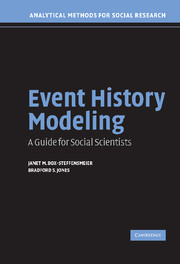Book contents
- Frontmatter
- Contents
- List of Figures
- List of Tables
- Preface
- 1 Event History and Social Science
- 2 The Logic of Event History Analysis
- 3 Parametric Models for Single-Spell Duration Data
- 4 The Cox Proportional Hazards Model
- 5 Models for Discrete Data
- 6 Issues in Model Selection
- 7 Inclusion of Time-Varying Covariates
- 8 Diagnostic Methods for the Event History Model
- 9 Some Modeling Strategies for Unobserved Heterogeneity
- 10 Models for Multiple Events
- 11 The Social Sciences and Event History
- Appendix: Software for Event History Analysis
- References
- Index
Preface
Published online by Cambridge University Press: 05 September 2012
- Frontmatter
- Contents
- List of Figures
- List of Tables
- Preface
- 1 Event History and Social Science
- 2 The Logic of Event History Analysis
- 3 Parametric Models for Single-Spell Duration Data
- 4 The Cox Proportional Hazards Model
- 5 Models for Discrete Data
- 6 Issues in Model Selection
- 7 Inclusion of Time-Varying Covariates
- 8 Diagnostic Methods for the Event History Model
- 9 Some Modeling Strategies for Unobserved Heterogeneity
- 10 Models for Multiple Events
- 11 The Social Sciences and Event History
- Appendix: Software for Event History Analysis
- References
- Index
Summary
Our work on event history began in graduate school. We met as graduate students attending the Political Methodology Society's annual meeting in 1993 at Florida State University in Tallahassee, Florida. A small group of us at the meeting were interested in event history modeling and we saw its great potential for unlocking new answers to old questions and for revealing new questions in political science. We are indebted to the Political Methodology Group for bringing us together, providing a forum for us to present subsequent work, and providing ready and constructive critics and supporters. We are also indebted to our home departments for surrounding us with highly talented graduate students and interesting, stimulating colleagues. Meetings subsequent to our initial one in 1993, collaborations, and prodding from students and colleagues across the country who were interested in event history methodology, led to this manuscript.
This work has several goals. Our first goal in writing this book was to connect the methodology of event history to a core interest that social scientists, and indeed many scientists in fields as diverse as biostatistics and engineering, are interested in, namely understanding the causes and consequences of change over time. Scholars are commonly interested in “events.” For example, political scientists who study international relations might investigate the occurrence of a militarized dispute or criminologists might study instances of victimization. Events such as these connote change and frequently, this concern with events is concomitantly tied to an interest in the “history” preceding the event.
- Type
- Chapter
- Information
- Event History ModelingA Guide for Social Scientists, pp. xi - xivPublisher: Cambridge University PressPrint publication year: 2004



